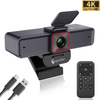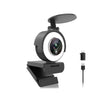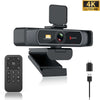
Starting a video call or web conference can be unexpectedly stressful. Is your webcam working properly? Is it compatible with the web conferencing software? Is everything set up correctly?
If the webcam isn't working properly when the meeting starts, it's too late. That's why it's a good idea to test your webcam before a scheduled call - it can help you avoid potential embarrassment if the video is configured incorrectly or doesn't work at all.
Whether it's used for video conferencing, live streaming, or other applications, making sure it's working properly is crucial. This article will show you how to test your webcam to make sure it delivers clear images and sound in a variety of situations.
Step 1: Checking and Connecting
Before starting the test, make sure the webcam is properly connected to your computer.
Check the connection port: Make sure the webcam is securely plugged into the computer's USB port or any other applicable adapter. Make sure the connection is tight and not loose. (It is best not to use a USB extension cable as it may not be sufficiently powered, resulting in problems such as lagging or flickering screens.)
Indicator Lights: Check the indicator lights on the webcam to make sure they are working properly.
Privacy cover: Since some webcams come with a privacy cover, make sure the privacy cover is closed before you start!
Restart your computer: If the webcam is still not working properly, try restarting your computer as this can sometimes resolve connection issues.
Step 2: Operating System Detection
Now, let's make sure your operating system can recognize and use the webcam device. This varies depending on your OS, and here are some common steps:
-
For Windows Operating Systems:
Open Device Manager: Right-click on "This PC" or "Computer," select "Manage," and in the left panel, locate "Device Manager."
Check the Webcam: In Device Manager, expand "Imaging devices" or "Cameras" and check if your webcam is listed correctly. If you see an exclamation mark or error message, you might need to update drivers.
Update Drivers: If driver updates are required, right-click on the webcam, select "Update driver," and follow the prompts.
-
For Mac Operating Systems:
Open System Preferences: Click on the Apple menu, select "System Preferences," and then click on "Security & Privacy."
Camera Access Permissions: In the "Privacy" tab, choose "Camera" and ensure that your applications have permission to access the camera.
Step 3: Testing with Built-in Applications
Most operating systems have built-in webcam applications that you can use to test basic functionality. Here are some examples:
-
Use Windows Camera (for Windows users):
Type "camera" in the Windows search bar and open the Camera application.
Click the Take Picture button to capture an image and check that the image is displayed correctly.
Click the Record button to test the video capabilities of the webcam.
-
Use Photo Booth (for Mac users):
Open the Applications folder, locate "Photo Booth" and launch the application.
Click the "Take Photo" button to capture an image and make sure it's clear.
Click the "Record Movie" button to test the video capabilities of your webcam.
-
Use the "Cheese" (for Ubuntu Linux users)
esting the webcam for Ubuntu Linux users is very simple. You don't have to be an advanced user of the command line because Ubuntu includes the free photo booth application Cheese.
Simply press the Windows/Option key (whichever applies) on your keyboard to open the search menu, then search for and open Cheese. it should immediately show you what your webcam sees.
Step 4: Using Third-Party Tools
-
Webcam Test: This online tool allows you to test the video and audio capabilities of your webcam and check its performance and settings.
-
Amcap: Amcap is a simple but powerful webcam testing tool for Windows. It displays live video streams and captures images.
-
Angetube Video Software: It helps you to adjust webcam resolution, autofocus, exposure value, etc.
Step 5: Test in Different Applications
How to test your webcam on Skype
To make sure your webcam is working properly in Skype, launch the desktop application and click on the three-dot menu on the left side of the window. Click Settings and then Audio and Video on the Settings page.

How to test your webcam on Zoom
Like Skype, Zoom makes it easy to test videos from the app's Settings screen. Launch Zoom and click on your account avatar in the top right corner of the window. In the drop-down menu, select Settings. In the Settings window, click Video and you should see a live view of the camera source at the top of the page.

By following these steps, you can ensure that your webcam always performs at its best, providing a great experience for your video conferencing, live streaming, and other online activities. If you encounter any issues, remember to check connections, drivers, and application permissions to find solutions. May your webcam always be in top-notch condition!
Related Articles








 Angetube 913Ai
Angetube 913Ai
 Angetube 866MAX
Angetube 866MAX
 Angetube 914Max
Angetube 914Max
 PTZ 4K 871Ai
PTZ 4K 871Ai
 Angetube @30fps 863Plus
Angetube @30fps 863Plus
 Angetube @60FPS 873Ai
Angetube @60FPS 873Ai
 Angetube 967Pro
Angetube 967Pro
 Angetube 967
Angetube 967
 Angetube 862Pro
Angetube 862Pro
 Angetube 920
Angetube 920
 Angetube 963
Angetube 963
 Angetube 962
Angetube 962
 Angetube 925c
Angetube 925c
 Angetube 628
Angetube 628
 Smart Notebook
Smart Notebook
 862Pro
862Pro
 863PLUS
863PLUS


